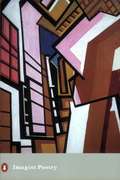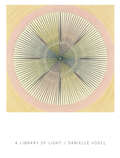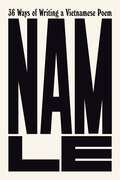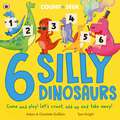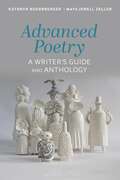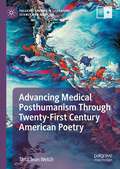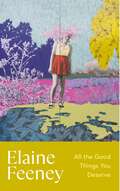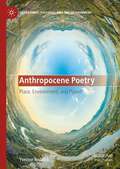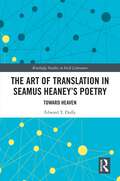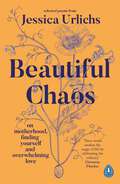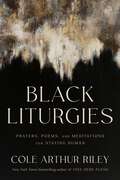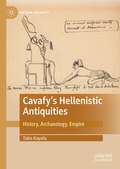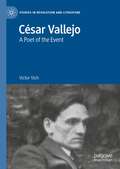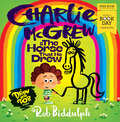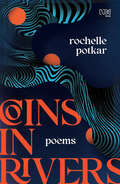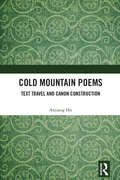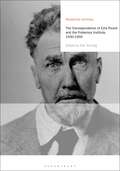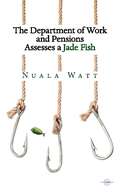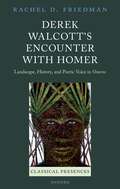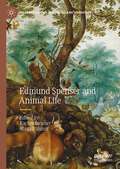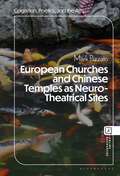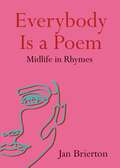- Table View
- List View
Imagist Poetry (Penguin Modern Classics)
by Peter JonesImagism was a brief, complex yet influential poetic movement of the early 1900s, a time of reaction against late nineteenth-century poetry which Ezra Pound, one of the key imagist poets, described as ‘a doughy mess of third-hand Keats, Wordsworth … half-melted, lumpy’. In contrast, imagist poetry, although riddled with conflicting definitions, was broadly characterized by brevity, precision, purity of texture and concentration of meaning: as Pound stated, it should ‘use no superfluous word, no adjective, which does not reveal something … it does not use images as ornaments. The image itself is the speech’. It was this freshness and directness of approach which means that, as Peter Jones says in his invaluable Introduction, ‘imagistic ideas still lie at the centre of our poetic practice’.
A Library of Light (Wesleyan Poetry Series)
by Danielle VogelWhen poet Danielle Vogel began writing meditations on the syntax of earthen and astral light, she had no idea that her mother's tragic death would eclipse the writing of that book, turning her attention to grief's syntax and quiet fields of cellular light in the form of memory. Written in elegant, crystalline prose poems, A Library of Light is a memoir that begins and ends in an incantatory space, one in which light speaks. At the book's center glows a more localized light: the voice of the poet as she reflects, with ceremonial patience, on the bioluminescence of the human body, language's relationship to lineage, her mother's journals written during years of estrangement from her daughter, and the healing potential of poetry. A mesmerizing elegy infused with studies of epigenetic theory and biophotonics, A Library of Light shows that to language is to take part in transmission, transmutation of energy, and sonic (re)patterning of biological light.[sample poem]When we are. When we are there, we lay together and cover ourselves with our voices. When we are ten, we are also twenty-one. We speak of breathing, but this is a thing we cannot do. When we are seven, we are also eighteen. When we are eighteen, we begin our bodies. But we are unmappable,unhinged. A resynchronization of codes, thecrystalline frequencies of stars, seeds, vowels, lying dormant within you. We are the oldest dialect. Asound the voice cannot make but makes.
36 Ways of Writing a Vietnamese Poem
by Nam LeAn explosive, devastating debut poetry book from the winner of the Dylan Thomas Prize 36 Ways of Writing a Vietnamese Poem is an urgent, unsettling reckoning with identity – and the violence of identity. For Le, a Vietnamese refugee in the West, this means the assumed violence of racism, oppression and historical trauma. But it also means the violence of that assumption. Of being always assumed to be outside one’s home, country, culture or language. And the complex violence – for the diasporic writer who wants to address any of this – of language itself. Making use of multiple tones, moods, masks and camouflages, Le’s poetic debut moves with unpredictable and destabilizing energy between the personal and political. As self-indicting as it is scathing, hilarious as it is desperately moving, this is a singular, breakthrough book.
6 Silly Dinosaurs: a counting and number bonds picture book
by Adam Guillain Charlotte GuillainIt's time for count and seek - would you like to come and play?Let's count up all the dinosaurs and see who's here today!Count and spot the silly dinosaurs in this madcap, rhyming picture book. From T. rex magicians to dancing Diplodocus, this hilarious picture book encourages children to learn basic sums through play and interactivity.As well as basic counting and sums, this book introduces children to numbers bond and fact friends for the number 6.With playful characters to spot and bouncy rhyming text, this engaging picture book is perfect for sharing with a child to support their learning in a fun way.
Advanced Poetry: A Writer's Guide and Anthology (Bloomsbury Writer's Guides and Anthologies)
by Kathryn Nuernberger Maya Jewell ZellerA text for practiced poets, this book offers a springboard beyond the basics into more daring poetic traditions, experimentation and methods. It lays out the myriad conversations influencing contemporary poetics, paying attention to its roots in historical and theoretical thinking. With a focus on innovation and breaking established boundaries, Advanced Poetry introduces you to the poetics shaping the contemporary literary moment, first guiding you through the contexts and principles of these forms using a range of practical examples, before prompting you to pick up the pen yourself. Spanning decades and continents, and covering the rich field of poets writing today, this book shows how to read, explicate, and write poetry and includes discussion of: - received traditions and innovative forms- confessional and epistolary poetry - aesthetic experimentation with voice - methods and theories developed by early Surrealists-deep image and the poetics of spells - ecopoetics & poetry of place - writing the body based on queer theory and disability studies - docupoetics and lyric research - racial imaginaries and poetics of liberation - digital poetics - writing in community with other poets and collaborative, interdisciplinary projects - revision processes and putting together a collection or chapbook-advice on writing artist statements and other professional materials Bringing together a comprehensive craft guide with a carefully collated anthology showcasing the (existing) limits of what is possible in poetry, this text explores how poetry since the 20th century has embraced traditional structures, borrowed from other disciplines, and invented wildly new forms. With close readings, writing prompts, excerpts of interviews from key figures in the field and a supplementary companion website, this is the definitive text for any poet looking to continue their poetic journey.
Advancing Medical Posthumanism Through Twenty-First Century American Poetry (Palgrave Studies in Literature, Science and Medicine)
by Tana Jean WelchAdvancing Medical Posthumanism Through Twenty-First Century American Poetry places contemporary poetics in dialogue with posthumanism and biomedicine in order to create a framework for advancing a posthuman-affirmative ethics within the culture of medical practice. This book makes a case for a posthumanist understanding of the body—one that sees health and illness not as properties possessed by individual bodies, but as processes that connect bodies to their social and natural environment, shaping their capacity to act, think, and feel. Tana Jean Welch demonstrates how contemporary American poetry is specifically poised to develop a pathway toward a posthuman intervention in biomedicine, the field of medical humanities, medical discourse, and the value systems that guide U.S. healthcare in general.
All the Good Things You Deserve
by Elaine FeeneyHow do we love, trust and create in the aftermath of trauma? How do we name and speak that love?In this powerful new collection from acclaimed poet and novelist Elaine Feeney, images andmemory circle and recur, and the journey from pain towards a place of greater safety is far from linear. All the Good Things You Deserve juxtaposes violence, hurt and the tyranny of shame with love, beauty and the transformative possibilities of art.
Anthropocene Poetry: Place, Environment, and Planet (Literatures, Cultures, and the Environment)
by Yvonne ReddickAnthropocene Poetry: Place, Environment and Planet argues that the idea of the Anthropocene is inspiring new possibilities for poetry. It can also change the way we read and interpret poems. If environmental poetry was once viewed as linked to place, this book shows how poets are now grappling with environmental issues from the local to the planetary: climate change and the extinction crisis, nuclear weapons and waste, plastic pollution and the petroleum industry. This book intervenes in debates about culture and science, traditional poetic form and experimental ecopoetics, to show how poets are collaborating with environmental scientists and joining environmental activist movements to respond to this time of crisis. From the canonical work of Ted Hughes and Seamus Heaney, to award-winning poets Alice Oswald, Pascale Petit, Kei Miller, and Karen McCarthy Woolf, this book explores major figures from the past alongside acclaimed contemporary voices. It reveals Seamus Heaney’s support for conservation causes and Ted Hughes’s astonishingly forward-thinking research on climate change; it discusses how Pascale Petit has given poetry to Extinction Rebellion and how Karen McCarthy Woolf set sail with scientists to write about plastic pollution. This book deploys research on five poetry archives in the UK, USA and Ireland, and the author’s insider insights into the commissioning processes and collaborative methods that shaped important contemporary poetry publications. Anthropocene Poetry finds that environmental poetry is flourishing in the face of ecological devastation. Such poetry speaks of the anxieties and dilemmas of our age, and searches for paths towards resilience and resistance.
The Art of Translation in Seamus Heaney’s Poetry: Toward Heaven (Routledge Studies in Irish Literature)
by Edward T. DuffyThe Art of Translation in Seamus Heaney’s Poetry is a critical study of the poet's later work. While exploring his practice as a translator, it also traces his increasing preoccupation with the possibilities and conditions of translation in the theological sense of being lifted up in spirit. To the work of this philosophical poet, who would be both “earthed and heady” this book brings the insights of ordinary language philosophy as practiced by Stanley Cavell. It devotes separate chapters to Station Island and three later collections: Seeing Things, Electric Light and Human Chain. The first of these addresses the most fundamental change in Heaney’s life when he acknowledges the “need and chance to re-envisage” his Irish-Catholic upbringing; it is also replete with both the activity and the trope of translation. Published seven years later, Seeing Things begins with a translation of Virgil’s golden bough episode and ends with a similar crossing over into the underworld by Dante. Heaney transforms both into poems about poetry. In Electric Light, Heaney returns to Virgil, but now he concentrates not on the hero of the Aeneid but on Virgil's earlier efforts in pastoral, a mode of writing that Heaney takes as a model for his own time and place of “devastated order.” Heaney returns to the Aeneid in Human Chain, but this time around he gives all his attention to the scene of the human souls in Elysium seeking rebirth and turns it into an image for the need and chance of pronouncing “a final Yes” to our world and our place in it.
The Art of Translation in Seamus Heaney’s Poetry: Toward Heaven (Routledge Studies in Irish Literature)
by Edward T. DuffyThe Art of Translation in Seamus Heaney’s Poetry is a critical study of the poet's later work. While exploring his practice as a translator, it also traces his increasing preoccupation with the possibilities and conditions of translation in the theological sense of being lifted up in spirit. To the work of this philosophical poet, who would be both “earthed and heady” this book brings the insights of ordinary language philosophy as practiced by Stanley Cavell. It devotes separate chapters to Station Island and three later collections: Seeing Things, Electric Light and Human Chain. The first of these addresses the most fundamental change in Heaney’s life when he acknowledges the “need and chance to re-envisage” his Irish-Catholic upbringing; it is also replete with both the activity and the trope of translation. Published seven years later, Seeing Things begins with a translation of Virgil’s golden bough episode and ends with a similar crossing over into the underworld by Dante. Heaney transforms both into poems about poetry. In Electric Light, Heaney returns to Virgil, but now he concentrates not on the hero of the Aeneid but on Virgil's earlier efforts in pastoral, a mode of writing that Heaney takes as a model for his own time and place of “devastated order.” Heaney returns to the Aeneid in Human Chain, but this time around he gives all his attention to the scene of the human souls in Elysium seeking rebirth and turns it into an image for the need and chance of pronouncing “a final Yes” to our world and our place in it.
Beautiful Chaos: On Motherhood, Finding Yourself and Overwhelming Love
by Jessica UrlichsThe perfect gift for mums and mums-to-be this Mother’s Day'The words awaken the magic of life by celebrating the ordinary' - Giovanna Fletcher'Beautifully heartfelt, inspiringly poignant and therapeutically validating' - Anna Mathur Motherhood is messy and beautiful, and hard and humbling. We adore our children, and sometimes we miss ourselves. Beautiful Chaos is a collection of raw, honest poems about motherhood - capturing everything from pregnancy to school age. Upon becoming a mother, poet Jessica Urlichs was reminded that the everyday ordinary is extraordinary. Beautiful Chaos is a collection that chronicles it all - the highs, the lows, the confusion, the loss of identity, the becoming, and the brutal but beautiful ways our children hold up a mirrors to ourselves. This collection inspires vulnerability and will be a cathartic, healing read for anyone who needs it. These poems will remind you of a time gone by or ground you in the current moment. Either way, they will make you feel seen and comforted amid the beautiful chaos that is motherhood.
Black Liturgies: Prayers, poems and meditations for staying human
by Cole Arthur RileyIn the summer of 2020, Cole Arthur Riley was desperate for a spirituality she could trust. Amidst ongoing national racial violence, the isolation of the pandemic, and a surge of anti-Black rhetoric in many Christian spaces, she began dreaming of a harbour for a more human, more liberating expression of faith. She went on to create Black Liturgies, a digital project that connects spiritual practice with Black emotion, memory, and the Black body.In this book, she deepens the work of that project, bringing together new prayers, letters, poetry, meditation questions, breath practice, and the writings of Black literary ancestors to offer 43 liturgies that can be practised individually or as a community. With a poet's touch and a sensitivity that has made her one of the most important spiritual voices at work today, Riley invites readers to reflect on their own experiences of wonder, rest, rage, and repair, while also including liturgies for holidays like Lent, Advent and Mother's Day.For those healing from spiritual spaces that were more violent than loving; for those who have escaped the trauma of white Christian nationalism, religious homophobia, and transphobia; for anyone asking what it means to be human in a world of both beauty and terror; Black Liturgies is a work of healing and liberation, and a vision for what might be.
Cavafy's Hellenistic Antiquities: History, Archaeology, Empire (The New Antiquity)
by Takis KayalisThis book reinterprets C. P. Cavafy’s historical and archaeological poetics by correlating his work to major cultural, political and sexualized receptions of antiquity that marked the turn of the 20th century. Focusing on selected poems which stage readings of Hellenistic and late ancient texts and material objects, this study probes the poet's personal library and archive to trace his scholarly sources and scrutinize their contribution to his creative practice. A new understanding of Cavafy's historicism emerges by comparing his poetics to a broad array of discourses and intellectual pursuits of his time; these range from antiquarianism, physiognomy and Egyptomania to cultural appropriations of the classics which sought to legitimate British colonial rule as well as homoerotic desire. As this volume demonstrates, Cavafy embraced antiquarianism as an empathetic and passionate way of relating to the past and shaped it into a method that allowed his poetry to render modern meanings to Hellenistic antiquities.
César Vallejo: A Poet of the Event (Studies in Revolution and Literature)
by Víctor VichThis book argues that the poetry of César Vallejo announces the event, as a moment of irruption of a truth that destabilises the usual state of reality. It studies the emergence of a subject who affirms a truth that exceeds the law, interrupts hegemonic repetition, asserts universal solidarity, and defends "lost causes" despite political failure. The author reconfigures the traditional reading of Vallejo only as a poet of pain and human suffering, and offers new ways of understanding the relationship between poetry and politics.
Charlie McGrew & the Horse that he Drew (World Book Day 2024)
by Rob BiddulphCharlie McGrew longs for a clippety companion but the sign says NO PETS – can he draw one instead? World Book Day 2024
ClearRevise AQA GCSE English Literature 8702; Love and Relationships, Poetry anthology
by Pg OnlineClearRevise illustrated revision and practice. With over 150 marks worth of examination style questions, answers provided for all questions within the book along with examination tips and techniques. Each poem from the anthology is reproduced in full and with a complete summary and analysis to help students compare poems across the cluster. Exam-style questions are all specifically and carefully devised throughout this book.
Coins in Rivers: Poems
by Rochelle PotkarIf I were a country and you my journalist I would have shot you down a street and left you to bleed.Fierce and unflinching, Rochelle Potkar's poetry springs from the deeply personal and ripples out to the world, capturing lovers' whispers and reverberations of explosions with equal ease. Vividly depicting love, grief, anger, and defiance, these poems glimmer like coins beneath the water surface, tethered with the weight of wishes clinging to them. As sensuous as it is articulate, Coins in Rivers is a deep meditation on womanhood, motherhood, and citizenship.
Cold Mountain Poems: Text Travel and Canon Construction
by Anjiang HuThis book unveils the legendary life and the mystic poems of the iconic Chinese Tang poet Han-shan (known by his pen name “Cold Mountain”) and investigates the dissemination and reception of the Cold Mountain Poems (CMPs) attributed to him. Han-shan and the CMPs are amongst the most legendary literary landscapes and cultural memories in the history of world scholarly exchange. The maniac poet recluse hidden in the Cold Mountains, the delicate poetic realms of Confucianism, Buddhism, Zen and Taoism contained in the Cold Mountain Poems, and the incredible pervasiveness of its text travel and canon construction worldwide, as well as the profound impact of CMPs on comparative literature, world literature and Chinese studies, provide the perfect lens to learn about Chinese language, literature, culture and society. This book is thus intended to investigate CMPs in a coherent global context. Considering the vertical studies of the Chinese literature polysystem, it highlights the horizontal influence of CMPs, literarily or non-literarily. Furthermore, it addresses the making and developing of the Han-shan phenomenon and its implications for translation studies, travel writing, canon construction and literary historiography. This book is for scholars, researchers and students in literary history and East Asian Studies focusing on Chinese literature and culture and those interested in the history of poetry in general.
Cold Mountain Poems: Text Travel and Canon Construction
by Anjiang HuThis book unveils the legendary life and the mystic poems of the iconic Chinese Tang poet Han-shan (known by his pen name “Cold Mountain”) and investigates the dissemination and reception of the Cold Mountain Poems (CMPs) attributed to him. Han-shan and the CMPs are amongst the most legendary literary landscapes and cultural memories in the history of world scholarly exchange. The maniac poet recluse hidden in the Cold Mountains, the delicate poetic realms of Confucianism, Buddhism, Zen and Taoism contained in the Cold Mountain Poems, and the incredible pervasiveness of its text travel and canon construction worldwide, as well as the profound impact of CMPs on comparative literature, world literature and Chinese studies, provide the perfect lens to learn about Chinese language, literature, culture and society. This book is thus intended to investigate CMPs in a coherent global context. Considering the vertical studies of the Chinese literature polysystem, it highlights the horizontal influence of CMPs, literarily or non-literarily. Furthermore, it addresses the making and developing of the Han-shan phenomenon and its implications for translation studies, travel writing, canon construction and literary historiography. This book is for scholars, researchers and students in literary history and East Asian Studies focusing on Chinese literature and culture and those interested in the history of poetry in general.
The Correspondence of Ezra Pound and the Frobenius Institute, 1930-1959 (Modernist Archives)
by Ezra PoundCollecting in full for the first time the correspondence between Ezra Pound and members of Leo Frobenius' Forschungsinstitut für Kulturmorphologie in Frankfurt across a 30 year period, this book sheds new light on an important but previously unexplored influence on Pound's controversial intellectual development in the Fascist era. Ezra Pound's long-term interest in anthropology and ethnography exerted a profound influence on early 20th century literary Modernism. These letters reveal the extent of the influence of Frobenius' concept of 'Paideuma' on Pound's poetic and political writings during this period and his growing engagement with the culture of Nazi Germany. Annotated throughout, the letters are supported by contextualising essays by leading Modernist scholars as well as relevant contemporary published articles by Pound himself and his leading correspondent at the Institute, the American Douglas C. Fox.
The Department of Work and Pensions Assesses a Jade Fish: (pdf)
by Nuala WattA poetry collection focusing on visual impairment, welfare reform and its effects on disabled people and disabled parenthood as major topics.
Derek Walcott's Encounter with Homer: Landscape, History, and Poetic Voice in Omeros (Classical Presences)
by Rachel D. FriedmanDerek Walcott's Encounter with Homer puts Derek Walcott's epic poem Omeros in conversation with Homer, especially the Odyssey, to show how reading them against each other changes our understanding of the poems of both poets. It explores Walcott's conscious use of the Odyssey and the Homeric persona of Omeros to explore his own deepening relationship with his craft and his identity as a Caribbean poet. Walcott's ability to serve as the vessel of history for his people and their landscapes rests on his transformation into (and self-perception as) Homer's contemporary and equal. Central to the project of Omeros is thus an account of his shift from a diachronic to synchronic relationship with Homer: over the course of the poem his poetic persona, the "Poet", and Homer come to occupy the same temporality and creative space. By locating the poems of Walcott and Homer in a zone of vibrant and unexpected encounter, Rachel Friedman demonstrates how they can be seen as mutually informing texts, each made richer in the presence of the other. The argument follows two intertwined thematic threads. The first focuses on the poems' landscapes and seascapes and the ways in which Omeros reworks the Odyssey's affective geography. While the Odyssey represents the sea as a dangerous space and valorizes life on land, Walcott reverses this trajectory from sea to land, bearing witness to the painful histories carried in the St Lucian soil and relocating homecoming to the space of the Caribbean Sea, a space which accommodates diasporic histories and the imagining of fluid forms of emplacement. The second thread focuses on Walcott's poetic persona: his journey in and out of the poem and his positioning of himself as a "tribal poet" like Homer. Central to the project of Omeros is the Poet's account of the processes by which he becomes the poet who can adequately give voice to the histories of his people and the archipelago they inhabit.
Edmund Spenser and Animal Life (Palgrave Studies in Animals and Literature)
by Rachel Stenner Abigail ShinnThis book is the first extended critical study of the early modern poet Edmund Spenser from the perspective of animal studies. With an introduction situating Spenser in current discussions of animal life and literary form, and early modern animal studies, the book proceeds in four sections: “Animals and Cultural Practices”; “Animals, Slavery, and Race”; “Animals in Complaints”; “Readers and Poetics in The Faerie Queene”. Contributors discuss a broad range of Spenser’s work, putting it into dialogue with a number of early modern discourses, including politics, poetics, and natural history.
European Churches and Chinese Temples as Neuro-Theatrical Sites (Cognition, Poetics, and the Arts)
by Prof. or Dr. Mark PizzatoCompares monumental designs and performance spaces of Christian, Buddhist, and related sanctuaries, exploring how brain networks, animal-human emotions, and cultural ideals are reflected historically and affected today as "inner theatre" elements. Integrating research across the humanities and sciences, this book explores how traditional designs of outer theatrical spaces left cultural imprints for the inner staging of Self and Other consciousness, which each of us performs daily based on how we think others view us. But believers also perform in a cosmic theatre. Ancestral spirits and gods (or God) watch and interact with them in awe-inspiring spaces, grooming affects toward in-group identification and sacrifice, or out-group rivalry and scapegoating. In a study of over 80 buildings – shown by 40 images in the book, plus thousands of photos and videos online – Pizzato demonstrates how they reflect meta-theatrical projections from prior generations. They also affect the embodied, embedded, enacted, and extended (4E) cognition of current visitors, who bring performance frameworks of belief, hope, and doubt to the sacred site. This involves neuro-social, inner/outer theatre networks with patriarchal, maternal, and trickster paradigms. European Churches and Chinese Temples as Neuro-Theatrical Sites investigates performative material cultures, creating dialogs between theatre, philosophy, history, and various (cognitive, affective, social, biological) sciences. It applies them to the architecture of religious buildings: from Catholic, Orthodox, and Protestant in Europe, plus key sites in Jerusalem and prior “pagan” temples, to Buddhist, Daoist, Confucian, and imperial in China. It thus reveals individualist/collectivist, focal/holistic, analytical/dialectical, and melodramatic/tragicomic trajectories, with cathartic poetics for the future.
Everybody Is a Poem: Midlife in Rhymes
by Jan BriertonFor the multitaskers, the overreactors, the silent screamers and the quiet lovers Everybody Is a Poem: Midlife in Rhymes is Jan Brierton's second collection. Inspired by Jan's popular podcast these 52 poems delve into the darkest and brightest moments of our day, month or year. Combining rhyme and illustration, Jan puts simple words to those deepest of feelings. She riffs on menopause, midlife, the mental load, friendships, relationships, loss and self-acceptance. Plain-speaking and completely relatable, each poem is served with Jan's signature combination of humour, wit and poignancy. This is poetry for everybody.
